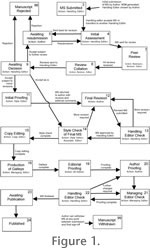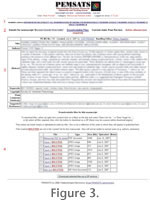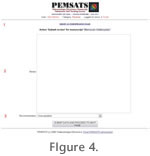
Into Focus
PEMSaTS—Electronic oil for the pe wheels
 Palaeontologia Electronica
is becoming a victim of its own success, and is receiving manuscripts at
an accelerating rate. Manuscripts, especially taxonomic monographs, are
becoming longer, include more figures, and involve multiple media
formats. Our existing methods of manuscript submission and tracking have
become strained; we are struggling to keep the transfer of manuscript
files between editors, reviewers and authors running smoothly. To put
manuscript handling on sounder footing, we have created the
Palaeontologia Electronica Manuscript Submission And Tracking
System (PEMSATS). PEMSATS is a custom-written application that
stores all manuscript files and details on a central server; it is
accessed via web-browser, and communicates with editors, authors and
reviewers by email. PEMSATS tracks each manuscript from initial
submission, through the review process and subsequent revision and
editing, and on to final publication. It is intended to make the entire
editorial system more efficient, consistent, and transparent. The system
will not only make submitting and reviewing manuscripts easier, but it
will speed up turnaround times; the first round of manuscripts through
the PEMSATS system have taken less than three months from submission to
acceptance. Figure 1, the PEMSATS
state diagram, shows in simplified form the PE manuscript lifecycle that
PEMSATS implements.
Palaeontologia Electronica
is becoming a victim of its own success, and is receiving manuscripts at
an accelerating rate. Manuscripts, especially taxonomic monographs, are
becoming longer, include more figures, and involve multiple media
formats. Our existing methods of manuscript submission and tracking have
become strained; we are struggling to keep the transfer of manuscript
files between editors, reviewers and authors running smoothly. To put
manuscript handling on sounder footing, we have created the
Palaeontologia Electronica Manuscript Submission And Tracking
System (PEMSATS). PEMSATS is a custom-written application that
stores all manuscript files and details on a central server; it is
accessed via web-browser, and communicates with editors, authors and
reviewers by email. PEMSATS tracks each manuscript from initial
submission, through the review process and subsequent revision and
editing, and on to final publication. It is intended to make the entire
editorial system more efficient, consistent, and transparent. The system
will not only make submitting and reviewing manuscripts easier, but it
will speed up turnaround times; the first round of manuscripts through
the PEMSATS system have taken less than three months from submission to
acceptance. Figure 1, the PEMSATS
state diagram, shows in simplified form the PE manuscript lifecycle that
PEMSATS implements.
 All authors submitting manuscripts to
PE are now asked to use PEMSATS. The process is simple and hopefully
transparent. After registering with the system to obtain a username and
password, the author simply logs on, follows the ‘submit a new
manuscript’ link (see Figure 2),
and is then taken through the steps of the submission process, including
the entry of title, abstract, keywords, author list and upload of files.
At any subsequent time the author can log on to see the status of their
manuscript, or to withdraw their manuscript. At certain stages in the
process authors will be required to modify their manuscript or comment
on proofs; all these actions are also performed through PEMSATS, which
will notify authors by email when they need to do anything, and also
remind them if action is overdue. When logging on, the system will
provide authors with context sensitive ‘action’ links on the manuscript
details page (see Figure 3) which
will let them know what they need to do with/to their manuscript.
All authors submitting manuscripts to
PE are now asked to use PEMSATS. The process is simple and hopefully
transparent. After registering with the system to obtain a username and
password, the author simply logs on, follows the ‘submit a new
manuscript’ link (see Figure 2),
and is then taken through the steps of the submission process, including
the entry of title, abstract, keywords, author list and upload of files.
At any subsequent time the author can log on to see the status of their
manuscript, or to withdraw their manuscript. At certain stages in the
process authors will be required to modify their manuscript or comment
on proofs; all these actions are also performed through PEMSATS, which
will notify authors by email when they need to do anything, and also
remind them if action is overdue. When logging on, the system will
provide authors with context sensitive ‘action’ links on the manuscript
details page (see Figure 3) which
will let them know what they need to do with/to their manuscript.
 Peer review is also now conducted
through PEMSATS. Reviewers are contacted by email, and accept or decline
the reviewing task by following a link to a webpage and clicking a
single button. Should they accept, a PEMSATS user account is generated
for them; after logging in they are able to download the manuscript for
offline viewing. To make life simpler, multiple files can be downloaded
as a single ZIP archive (see Figure 3).
Reviews are also submitted via PEMSATS; each reviewer just follows the
link for the ‘submit review’, pastes their review into the appropriate
box (see Figure 4), and selects
their recommendation from a drop-down list. To help keep things moving,
reviewers receive timed reminder emails about upcoming review deadlines.
This semi-automation of the review system will speed the entire peer
review system in several small but important ways; an example is speed
of access to the MS on acceptance. Under our old system, reviewers
accepted a MS for review by replying to an email from the Reviews
Editor. They were thus only able to access the manuscript and begin
reviewing once the Reviews Editor manually picked up their email and
sent the files by return. Using PEMSATS, a reviewer can access the
manuscript within seconds of their decision to accept, without the
intervention of the Reviews Editor. This is particularly helpful when
one of us is in the field.
Peer review is also now conducted
through PEMSATS. Reviewers are contacted by email, and accept or decline
the reviewing task by following a link to a webpage and clicking a
single button. Should they accept, a PEMSATS user account is generated
for them; after logging in they are able to download the manuscript for
offline viewing. To make life simpler, multiple files can be downloaded
as a single ZIP archive (see Figure 3).
Reviews are also submitted via PEMSATS; each reviewer just follows the
link for the ‘submit review’, pastes their review into the appropriate
box (see Figure 4), and selects
their recommendation from a drop-down list. To help keep things moving,
reviewers receive timed reminder emails about upcoming review deadlines.
This semi-automation of the review system will speed the entire peer
review system in several small but important ways; an example is speed
of access to the MS on acceptance. Under our old system, reviewers
accepted a MS for review by replying to an email from the Reviews
Editor. They were thus only able to access the manuscript and begin
reviewing once the Reviews Editor manually picked up their email and
sent the files by return. Using PEMSATS, a reviewer can access the
manuscript within seconds of their decision to accept, without the
intervention of the Reviews Editor. This is particularly helpful when
one of us is in the field.
 The introduction of PEMSATS will also
benefit PE Editors, because all our internal communications regarding
manuscripts will now be made using the system. This will make the whole
process of manuscript handling simpler and more efficient. For instance
the central storage of all manuscript files will ensure that we will
always know where the most recent versions are (and who uploaded them,
and when), and also avoid problems with multiple file versions. The
PEMSATS system cuts Handling Editor involvement out of the manuscript
lifecycle at several non-critical points, speeding throughput. Automatic
drafting of standard emails reduces our workload, while still enabling
us to customise the text as desired. Automatic reminders keep
manuscripts moving through the system by avoiding any confusion about
whose action is required. Central availability of status information
makes it much easier for us to see what needs doing and how things are
progressing; this is especially important for tracking peer reviews.
Finally, we will now more easily be able to examine our systems for
bottlenecks, and attempt to remove them. This will all be entirely
transparent to authors and reviewers of course, let alone to readers of
the journal, but that does not mean that the benefits will be invisible!
PEMSATS will speed manuscript throughput, while simultaneously enabling
us to spend far less time on the mundane work of composing emails,
shifting files around, and generally keeping manuscripts moving through
the system in an orderly fashion. We will be able to devote more time to
the real work of evaluating and improving the increasing number of
manuscripts that are submitted to us, and ensuring that
Palaeontologia Electronica remains a journal of the highest possible
quality.
The introduction of PEMSATS will also
benefit PE Editors, because all our internal communications regarding
manuscripts will now be made using the system. This will make the whole
process of manuscript handling simpler and more efficient. For instance
the central storage of all manuscript files will ensure that we will
always know where the most recent versions are (and who uploaded them,
and when), and also avoid problems with multiple file versions. The
PEMSATS system cuts Handling Editor involvement out of the manuscript
lifecycle at several non-critical points, speeding throughput. Automatic
drafting of standard emails reduces our workload, while still enabling
us to customise the text as desired. Automatic reminders keep
manuscripts moving through the system by avoiding any confusion about
whose action is required. Central availability of status information
makes it much easier for us to see what needs doing and how things are
progressing; this is especially important for tracking peer reviews.
Finally, we will now more easily be able to examine our systems for
bottlenecks, and attempt to remove them. This will all be entirely
transparent to authors and reviewers of course, let alone to readers of
the journal, but that does not mean that the benefits will be invisible!
PEMSATS will speed manuscript throughput, while simultaneously enabling
us to spend far less time on the mundane work of composing emails,
shifting files around, and generally keeping manuscripts moving through
the system in an orderly fashion. We will be able to devote more time to
the real work of evaluating and improving the increasing number of
manuscripts that are submitted to us, and ensuring that
Palaeontologia Electronica remains a journal of the highest possible
quality.
Technical details for the geekier reader: PEMSATS is written in PHP 5.1 using a MySQL database back-end, running on a Linux server. Swift Mailer is used for email, PECL Archive_Zip for ZIP file creation, and Xupload (a PERL/PHP hybrid) for file upload progress bars.